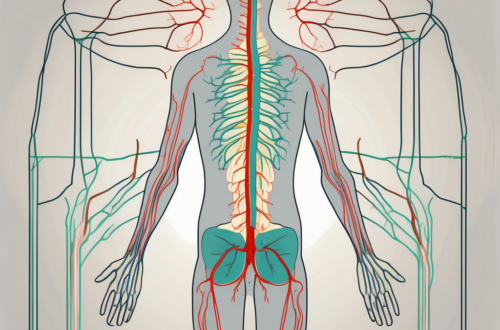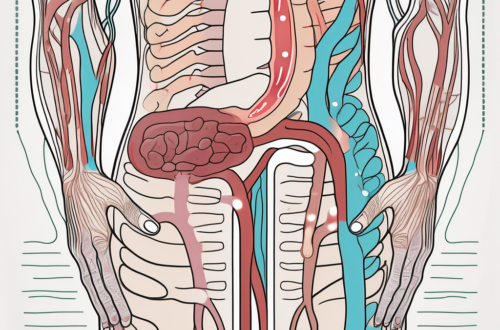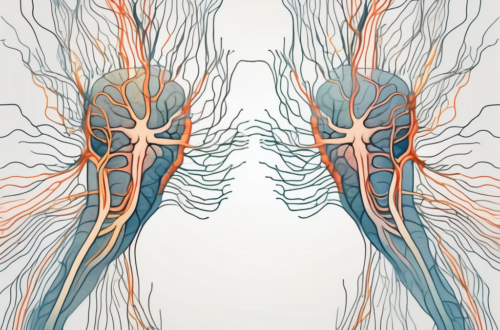The human body is an intricate web of systems and processes, all working together to maintain homeostasis and ensure our survival. One fundamental system that plays a key role in regulating various bodily functions is the nervous system. Within this expansive network, we find two distinct types of nerve fibers: sympathetic and parasympathetic. Understanding the difference between these two types is crucial in comprehending the complexity of human physiology.
Understanding the Nervous System
Before delving into the intricacies of sympathetic and parasympathetic nerve fibers, it is essential to grasp the basic functions of the nervous system. This elaborate network of cells, tissues, and organs acts as the body’s control center, coordinating and regulating bodily functions through electrical signaling.
The nervous system is divided into two main parts: the central nervous system (CNS) and the peripheral nervous system (PNS). The CNS consists of the brain and spinal cord, while the PNS encompasses all other nerves throughout the body that connect to the CNS.
The central nervous system, composed of the brain and spinal cord, is the command center of the entire nervous system. It receives and processes information from the peripheral nervous system, making decisions and sending out signals to various parts of the body.
On the other hand, the peripheral nervous system consists of a vast network of nerves that extend throughout the body, acting as messengers between the CNS and different organs, muscles, and tissues. It is responsible for relaying sensory information from the body to the brain, allowing us to perceive and respond to our environment.
The Role of Nerve Fibers
Within the peripheral nervous system, nerve fibers play a crucial role in transmitting signals between the CNS and various parts of the body. These fibers are like the communication highways of the nervous system, allowing information to travel quickly and efficiently.
There are two types of nerve fibers: sensory fibers and motor fibers. Sensory fibers transmit information from sensory receptors, such as those in the skin, to the CNS. This information includes sensations like touch, temperature, pain, and pressure. Motor fibers, on the other hand, carry signals from the CNS to muscles and glands, enabling voluntary and involuntary movements and the release of hormones.
The Division of the Nervous System
To better understand the difference between sympathetic and parasympathetic nerve fibers, it is vital to recognize their respective roles within the division of the autonomic nervous system (ANS). The ANS is responsible for controlling involuntary bodily functions, such as heart rate, digestion, and breathing, without conscious effort.
The autonomic nervous system is further divided into two complementary parts: the sympathetic nervous system (SNS) and the parasympathetic nervous system (PNS). These two systems work in tandem to maintain a delicate balance and ensure the body can adapt to different situations and stressors appropriately.
The sympathetic nervous system is often referred to as the “fight or flight” response system. It prepares the body for intense physical activity or emergencies by increasing heart rate, dilating blood vessels, and releasing stress hormones like adrenaline. This response allows us to respond quickly to perceived threats and mobilize energy for action.
On the other hand, the parasympathetic nervous system is responsible for the body’s “rest and digest” state. It promotes relaxation, conserves energy, and facilitates processes like digestion and elimination. When activated, the parasympathetic nervous system slows heart rate, constricts blood vessels, and enhances digestion and nutrient absorption.
Understanding the intricate workings of the nervous system and its various components, including nerve fibers and the autonomic nervous system, provides a foundation for comprehending the complexities of sympathetic and parasympathetic nerve fibers. These fibers, with their distinct roles and functions, contribute to the overall balance and regulation of bodily processes, ensuring our well-being and survival.
The Sympathetic Nervous System Explained
The sympathetic nervous system is often referred to as the “fight or flight” response system. It prepares the body for intense physical exertion or responses in times of danger or stress. This system is responsible for activating various physiological changes that enable a rapid, adaptive response.
When faced with a threatening situation, the sympathetic nervous system springs into action, orchestrating a series of intricate processes within the body. These processes are designed to optimize the body’s ability to survive and react effectively.
Function of Sympathetic Nerve Fibers
Sympathetic nerve fibers are involved in increasing heart rate, dilating blood vessels, and raising blood pressure. These responses ensure that oxygen and nutrients are efficiently delivered to vital organs and muscles, allowing for heightened physical performance.
Imagine a scenario where you encounter a wild animal while hiking in the woods. Your sympathetic nervous system would immediately kick in, causing your heart to beat faster, pumping oxygen-rich blood to your muscles. This surge of blood flow would provide you with the strength and agility needed to either fight off the animal or flee from it.
In addition to its role in cardiovascular regulation, the sympathetic nervous system also plays a crucial role in the release of stress hormones. When activated, sympathetic nerve fibers trigger the release of adrenaline and noradrenaline, providing a surge of energy and focus. This heightened state of alertness allows individuals to react quickly in the face of potential threats or emergencies.
Impact on Body Functions
Although the sympathetic nervous system primarily coordinates the “fight or flight” response, it also influences other bodily functions. For example, it inhibits digestive processes, constricts blood vessels in non-essential areas, and dilates the airways to enhance oxygen intake.
When the sympathetic nervous system is activated, blood flow is redirected away from the digestive system, as it is not a priority in times of danger or stress. This redirection of resources ensures that energy is conserved and available for immediate use in critical situations.
Furthermore, the sympathetic nervous system’s ability to constrict blood vessels in non-essential areas helps to maintain blood pressure and ensure that oxygenated blood reaches the vital organs and muscles. This mechanism is crucial for sustaining physical performance during intense physical exertion.
While an acute activation of the sympathetic nervous system can be beneficial in certain situations, prolonged or excessive activation can have negative implications on overall health. Chronic stress or anxiety can overstimulate the sympathetic response, leading to detrimental effects on physical and mental well-being.
It is important to find healthy ways to manage stress and anxiety to prevent the sympathetic nervous system from being constantly in overdrive. Engaging in relaxation techniques, practicing mindfulness, and maintaining a balanced lifestyle can help restore the body’s equilibrium and promote overall well-being.
The Parasympathetic Nervous System Uncovered
In contrast to the sympathetic response, the parasympathetic nervous system promotes a “rest and digest” state. This system is responsible for regulating normal bodily functions during periods of rest, relaxation, and digestion.
When it comes to the intricate workings of the human body, the parasympathetic nervous system plays a crucial role. It is like the conductor of a symphony, orchestrating a harmonious balance within our internal environment. Let’s dive deeper into the fascinating world of the parasympathetic response.
Role of Parasympathetic Nerve Fibers
Parasympathetic nerve fibers work to conserve energy and promote recovery. These fibers are responsible for slowing down heart rate, promoting digestion and nutrient absorption, and restoring the body to a state of rest.
Imagine a serene garden, where every plant and flower is meticulously tended to. Similarly, the parasympathetic response nurtures our body, ensuring that each organ and system receives the care it needs. By slowing down the heart rate, it allows the cardiovascular system to relax and recharge, preparing for the next burst of activity.
But the parasympathetic response doesn’t stop there. It extends its gentle touch to our digestive system, promoting the breakdown of food and absorption of nutrients. Like a skilled chef, it ensures that our body receives the nourishment it requires to function optimally.
Additionally, the parasympathetic response stimulates contraction of the bladder, promoting urination, and enhances the flow of saliva, aiding in digestion. These seemingly small activities are crucial for maintaining a healthy and balanced bodily state.
Influence on Body Activities
The parasympathetic nervous system is integral in promoting overall well-being. It fosters a state of relaxation and calmness, allowing the body to recuperate, repair, and restore itself. Proper functioning of the parasympathetic response is vital for maintaining a healthy digestive system, regular sleep patterns, and balanced mood.
Imagine a peaceful oasis, where the mind and body find solace. This is the state that the parasympathetic response strives to create. By promoting relaxation, it allows our body to enter a state of repair and rejuvenation. It is during these moments of tranquility that our cells regenerate, our muscles replenish, and our mind finds clarity.
However, an imbalance or dysfunction within the parasympathetic response can lead to various health issues, such as gastrointestinal disorders, sleep disturbances, or mood disorders. It’s important to listen to the whispers of our body and seek guidance when needed. Consulting with a healthcare professional is advised for individuals experiencing persistent symptoms or disruptions in these bodily functions.
So, the next time you find yourself in a state of rest and relaxation, take a moment to appreciate the intricate workings of the parasympathetic nervous system. It is the gentle guardian that ensures our body finds balance and harmony, allowing us to thrive in our daily lives.
Key Differences Between Sympathetic and Parasympathetic Nerve Fibers
While both sympathetic and parasympathetic nerve fibers are essential components of the autonomic nervous system, they exhibit distinct functions and effects on the body.
The autonomic nervous system is responsible for regulating involuntary bodily functions, such as heart rate, digestion, and breathing. It consists of two main divisions: the sympathetic nervous system and the parasympathetic nervous system.
Comparing Their Functions
The sympathetic nervous system is responsible for mobilizing the body for action, whereas the parasympathetic nervous system promotes relaxation and restoration. Sympathetic nerve fibers prepare the body for physical exertion and heightened sensory awareness.
For example, when faced with a dangerous situation, the sympathetic nervous system triggers the “fight or flight” response. This response increases heart rate, dilates the pupils, and diverts blood flow away from the digestive system towards the muscles, preparing the body for immediate action.
In contrast, parasympathetic nerve fibers facilitate digestion, sleep, and overall restoration. These fibers are active during periods of rest and relaxation, allowing the body to conserve energy and recover from physical and mental exertion.
During rest, the parasympathetic nervous system stimulates the release of digestive enzymes, increases blood flow to the digestive organs, and slows down heart rate. This promotes optimal digestion and nutrient absorption.
Contrasting Their Effects on the Body
In terms of physiological effects, sympathetic nerve fibers increase heart rate, blood pressure, and oxygen intake. These changes prepare the body for immediate action and enhance physical performance.
For example, during exercise or a stressful situation, sympathetic nerve fibers stimulate the release of adrenaline and noradrenaline, which increase heart rate, dilate the airways, and improve oxygen delivery to the muscles.
In contrast, parasympathetic nerve fibers reduce heart rate, promote digestion, and conserve energy. When the body is at rest, parasympathetic activity dominates, allowing for the restoration and replenishment of energy reserves.
The overall impact of these systems can be seen in their influence on different bodily activities. The sympathetic response prepares the body for immediate action, allowing for survival in threatening situations.
On the other hand, the parasympathetic response promotes long-term well-being and recovery. It ensures that essential bodily functions, such as digestion and sleep, are prioritized, enabling the body to maintain optimal health and function.
In summary, while both sympathetic and parasympathetic nerve fibers are crucial for the proper functioning of the autonomic nervous system, they have distinct roles and effects on the body. Understanding these differences helps us appreciate the complexity and balance of our physiological responses to various stimuli.
The Interplay Between Sympathetic and Parasympathetic Systems
Although the sympathetic and parasympathetic systems seem to have divergent functions, they work synchronously to maintain balance and adapt to different situations.
Balancing Act of the Nervous System
The interplay between the sympathetic and parasympathetic nervous systems ensures that the body can effectively respond to various stressors and demands. These systems function as a seesaw, constantly adjusting and regulating bodily functions to maintain equilibrium.
Imagine a tightrope walker, carefully navigating their way across a thin wire. Just like the tightrope walker, the sympathetic and parasympathetic systems work in perfect harmony to keep the body in balance. They act as the tightrope walker’s arms, constantly adjusting and shifting their weight to prevent any missteps.
For instance, after an intense physical activity or heightened stress response, the parasympathetic system kicks in to restore the body to a calm and balanced state. It’s like a gentle breeze that cools down the body after a hot and intense workout. This balancing act is essential for optimal health and well-being.
The Fight or Flight vs Rest and Digest Concept
The contrasting concepts of “fight or flight” and “rest and digest” epitomize the dynamic relationship between sympathetic and parasympathetic responses. While the sympathetic response enables immediate action and survival, the parasympathetic response facilitates recovery, nourishment, and long-term well-being.
Imagine you’re walking in a forest when suddenly a bear appears in front of you. Your heart starts racing, your breathing becomes rapid, and your muscles tense up. This is the fight or flight response, triggered by the sympathetic system, preparing you to either confront the bear or run away as fast as you can.
Now, imagine you’ve successfully escaped the bear and found a safe place to rest. Your heart rate slows down, your breathing becomes steady, and your muscles relax. This is the rest and digest response, facilitated by the parasympathetic system, allowing your body to recover from the intense experience and focus on nourishing itself.
Finding a harmonious balance between these two systems is essential for overall health. Engaging in relaxation techniques, practicing mindfulness, maintaining a healthy lifestyle, and managing stress can contribute to achieving this delicate equilibrium.
Just like a conductor leading an orchestra, the body’s nervous system orchestrates the symphony of sympathetic and parasympathetic responses, ensuring that each note is played at the right time and in perfect harmony. It’s a dance between two partners, gracefully moving together to create a beautiful and synchronized performance.
Implications of Sympathetic and Parasympathetic Imbalance
When the sympathetic and parasympathetic systems are imbalanced, it can have significant implications for overall health and well-being.
Health Conditions Related to Nervous System Imbalance
An overactive sympathetic response or underactive parasympathetic response can lead to the development or exacerbation of various health conditions. These may include chronic stress, high blood pressure, gastrointestinal disorders, sleep disturbances, and mood disorders.
Identifying and addressing imbalances in the autonomic nervous system often requires medical intervention and professional guidance. Consulting with a healthcare provider is essential to determine the underlying causes and develop an appropriate treatment plan.
Importance of Maintaining Balance
Maintaining a harmonious balance between sympathetic and parasympathetic responses is instrumental in promoting overall health and well-being. Finding strategies to manage stress, engaging in activities that promote relaxation and self-care, and prioritizing mental and physical wellness are key steps towards achieving equilibrium.
It is crucial to remember that this article serves as an informative resource and does not provide medical advice. If you have concerns about your nervous system function or suspect an imbalance, consulting with a healthcare professional is highly recommended.
In conclusion, understanding the difference between sympathetic and parasympathetic nerve fibers provides valuable insight into the complex workings of the human body. These two systems play integral roles in ensuring our survival, regulating bodily functions, and maintaining a delicate balance. Recognizing the diverse functions and effects of sympathetic and parasympathetic nerve fibers can empower individuals to prioritize their overall health and well-being.





